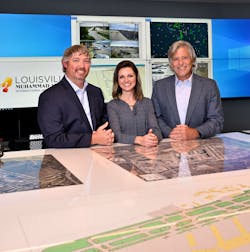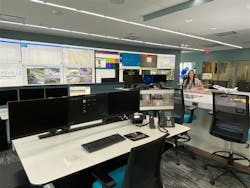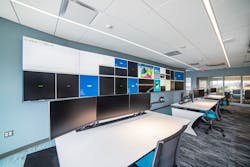This article also appears in the November 2021 issue of Security Business magazine.
What began as a relatively straightforward security systems upgrade in December 2019 at Louisville Muhammad Ali International Airport (SDF) quickly evolved into an ambitious total build-out of an advanced operations center, which the new airport leadership team felt was crucial to transforming the facility into a showcase for security and business operations.
When the public safety team put together its initial framework for security upgrades several years ago, they were looking to retrofit an access control system that had evolved from its 1999 Y2K compliance days – a system that simply was not ready to meet the stringent security requirements of the post-9/11 world, where aviation is heavily regulated. Former airport leadership began with the idea of proceeding with a security systems upgrade to include access control, video surveillance and a modernized communications center.
With the 2018 arrival of Dan Mann as the Executive Director of the Louisville Regional Airport Authority and his accompanying management team, the reimagined goal was simple from day one: build for the future, but continue to operate at an optimum level to meet current challenges.
“The crucial role of the operations department was an immediate priority for me – making sure we assembled the best team and gave them the best tools, resources and technology to do their job,” Mann says. “The technology and capabilities we have from the new airport operations center, coupled with the staff’s expertise, enable us to take that next step in the industry and be a leading example for other airports. The technology that we have in the new operations center – along with the ability to access the information there or remotely – is a huge improvement and will positively impact our overall operational efficiencies.”
Because of its vision for the future, while working within the scope of current needs, the project was chosen as a 2021 Security Vanguard Award honorable mention project.
The Project Scope
Consultant firms Sentinel Consulting and Aviation Security Consulting Inc. (ASC) led the consulting efforts on the Louisville airport project – reviewing all of the new security technologies and assisting the airport executives in making sound decisions on the type of technologies most appropriate for the airport’s immediate demands and its projected growth.
ASC was the prime consultant for the project and spearheaded the identity management and badging systems.
Sentinel designed and managed the upgrade of all electronic security systems throughout the airport and managed the space planning and design of the airport operations center and supporting network infrastructure.
Operations staff closely monitor flight and parking information, weather, terminal activity, property work orders, access control systems, and airport radio communications – including public safety, operations and maintenance, and aircraft radio traffic – from five workstations and three private offices in the command center.
There is a 14-screen video wall spanning nearly 28 feet that is fully customizable to offer a variety of configurations based on need. The centralized building automation system that monitors all HVAC, lighting, fire alarm, fire suppression and plumbing systems is also housed in this facility.
“The initial vision of the project was honestly to remain compliant,” explains Megan Atkins Thoben, who has been Director of Operations and Business Development for the Louisville Regional Airport Authority since 2018.
“We started on a basic level because our systems were outdated and they had not been looked at or analyzed in a long time,” adds Thoben, who worked with Mann at Columbia (SC) Metropolitan Airport before joining him at SDF. “It was decided to bring in experts to do that analysis and make recommendations for how the airport could bring its technology up to spec to meet current challenges, but more importantly, remain TSA-compliant.”
Thoben says the aviation security consultants who were brought on board in the 2016-17 time frame initially began an analysis of the access control system and cameras, recommending, for the most part, a complete replacement.
Mann and Thoben came to the realization that the project entailed more than they had originally planned. “At that point, knowing we needed to start from the ground up, it worked well that the organization was evolving with new leadership and new direction,” Thoben says. “[Mann] was a big proponent and cheerleader for airport operations and the importance of having a modern department in an airport of our size. It is a difference-maker when you have so many stakeholders, especially one like UPS Worldport.”
Thoben says the next step was determining what should be incorporated into an ideal airport operations center, and how to go about working with vendors to achieve it.
Shifting Priorities
For Paul Benne, PSP, CPOI, President/CEO of Sentinel Consulting, and Lori Beckman A.A.E., President of ASC, the challenges of shifting project priorities also offered them opportunities to bring added functionality to the airport and the operations center.
“Once we changed directions, we still had the base project – access control, credentialing, video surveillance and intrusion detection – but we also now needed to provide a very modern operations center,” Benne says. “All airport departments were in different areas. If you wanted to go to airport security operations, you had to go to the firefighting facility, which was in the middle of the runway – which was not very convenient.”
Beckman insists that for a project of this size and with multiple stakeholders, employing a team approach with a specialized staff ensured that all of the consultant firms – including K2 Security Consulting; Kersey & Kersey Architects; Chester Consulting for network design; CMTA, which specializes in MEP systems; and civil engineering firm HNTB – would have the flexibility to choose the best candidates from their various disciplines to meet the specific needs of a project.
As part of the SDF Next modernization program, the airport and the operations center became the foundation for other facility and systems upgrades over the next several years.
“SDF Next included many improvement projects airport-wide that ended up impacting the overall security system design and new SOC, conference room, credentialing office, access control and identity management system projects,” Beckman explains. “We have great sub-consultants who were able to quickly adapt to new and changing system design requirements.”
SDF leadership wanted to keep operations staff mobile as much as possible as part of the security and ops center project. The design team looked at technologies that could achieve this goal with an efficient implementation that was user interface-friendly for the operations staff.
Benne and the other consulting teams realized that having a centralized operations solution also meant finding technology partners that could meet the mobility needs of the airport security and operations personnel.
“When you are operating with very high utilization of staff, they tend not to be sitting at a desk waiting for something to happen – they are out in the airport, handling security and airport operations,” Benne says. “Airport [officials] asked for as much mobile technology as possible. They wanted to be able to not only initiate different types of operations from a remote standpoint, but they also wanted to be able to receive alerts and to perform other airport operations and security functions remotely. Getting them real-time information on mobile devices was crucial.”
Security and IT Projects Meet in the Middle
Supervising parallel technology installation projects was a unique task for both Thoben and David Prince, who has been Director of IT for SDF since 2018 and with the department since 2008. As the operations center was progressing, tying in the security and communication systems upgrades needed to stay on track as well.
“We went about scoping and procuring Genetec as a part of this project, which was a sizable portion of the cost and effort,” Thoben says. “Doing a complete PACS migration from one (system) to the other is not for the faint of heart. It was – and still is – quite the endeavor. Plus, there are new Axis cameras around the airport to monitor every access point in secured areas with a dedicated camera. The cameras can be tied to any alarm event at any of those secured access points.”
Thoben explains that the next step was designing the platform for the video feeds in the operations center, so all the live streaming data would be within reach of the operators.
“That’s why we have a 14-monitor video wall that is controlled by Primeview,” Thoben says. “It brings in access control and cameras, along with any software solution that we have operating. The bottom line is we are airport operations people, and we can’t be tied to a desk. The Genetec [Security Center] platform enabled all information to be fed to a mobile device. That checked off an important box.”
Another game-changer for the airport has been its new badging and identification technology. Using the HID SAFE solution, Thoben sees plenty of future integration possibilities. “We did go through an IDMS (Identification Management System) implementation throughout this entire process, which has been life-changing for our tenants,” Thoben says. “They were used to the paperwork; they were used to handing back and forth for an authorized signer. Now, it is all web-based and electronic, which makes it a lot faster for them. It also cuts down on the kind of interaction that we need to have with them, because a lot of the steps are taken care of before they even enter the badging office.”
Thoben adds that the project’s goal is full integration of the cameras, the access control system and data from the airport’s advanced real-time Automatic Dependent Surveillance-Broadcast (ADS-B), for important event-to-action situations that occur regularly.
For Prince, retooling the airport’s network infrastructure was not an option when Mann and Thoben asked for more sophisticated security and communications solutions.
“To meet the needs of new cameras, security systems and mobility, we had to do a complete rebuild of the infrastructure,” Prince explains. “Over the last 18 months, we have run new fiber across the campus to all of our nodes.”
Prince adds that the airport has purchased all new switching or switches for nearly 40 different comm closets, along with wireless controllers, access points, core switching firewalls – all new features and equipment not possible with the previous system.
“It was a good time for the project, because those items were starting to age,” Prince says. “Nowadays you blink and stuff in the technology world is old, so it was a really good time to combine the security project and infrastructure project.”
For Prince, that also meant replacing servers and storage, to enable the bandwidth to meet the airport’s video surveillance retention policies.
Collaboration Was Key
Beckman and the others on the project team have withstood the challenges of project migration, COVID-19, new technology integration, and a fast-track schedule to create a successful outcome. The collaborative effort is something Beckman appreciated.
“Flexibility was a key component of this project,” Beckman says. “The leadership change resulted in significant project changes; each year, project milestones also had to be timed around the flood of general aviation aircraft and passengers [due to] the Kentucky Derby; and COVID-19 caused some of the work to be reassessed and reprioritized.”
Steve Lasky is Editorial Director of Endeavor Business Media Security Group. Read about the other Vanguard Award projects at www.securityinfowatch.com/vanguard.






